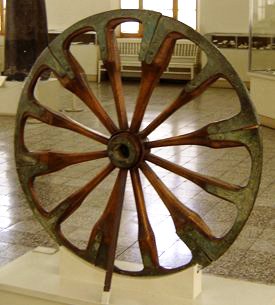|
Vikidia currently has 4,625 articles. Improve it! |
|
Join Vikidia: create your account now and improve it! |
Wheel
A wheel is a circular object that, together with an axle, rolls easily. They are first widely used for transport. Wheel can mean lots of other circular objects that turn, like a steering wheel and flywheel.
Invention[edit | edit source]
The wheel was invented in prehistoric times and probably its discovery was repeated many times independently. The oldest example of a wheel yet found is from the region of Mesopotamia (Iraq), so it may have been invented around the area where Iraq is today. The wheel may have been inspired by a simple observation of a rolling tree trunk. When a number of tree trunks are placed on the ground close together, and a weight is placed upon them, the object can be moved much more easily. The rolling trunks cause less friction than dragging the object on the ground.
The first wheels were indeed tree trunks. The next development was to use slices of these trunks joined together through an axle. Later, these wheels became wooden disks cut into a circular shape with a hole for the axle. The oldest wooden wheel archaeologists have found was built somewhere between 3350 and 3100 BC. Because the first wheels were made from wood, and wood rots and breaks down over time, we can assume that other wheels might have existed earlier.
Wheels with spokes were invented more recently. This type of wheel allowed people to make lighter and faster vehicles. The earliest known examples were from chariots built about 2000 BC.
Power[edit | edit source]
A wheel has to have some external power source in order to move. When you pick up a wheelbarrow and roll it along in front of you, you are the power source. The engine is the power source for the wheels on a car.
But the reason that the wheel is a very important and useful technology is because of its mechanical advantage. The wheel gains its mechanical advantage because it reduces friction.

Rolling and friction[edit | edit source]
A wheel works by rolling. Rolling is an efficient way to reduce friction. When you slide a block across a smooth surface, it will slide for a short distance and then come to a stop. When you roll a ball across that surface, it will roll a long way.
There are two basic parts of wheels; the wheel and the axle. The wheel itself is a round disk. The axle is a shaft positioned in the center of the disk. Sometimes the disk itself spins on the axle. Often the axle is fixed to the disk and the wheel and axle turn together.

When a wheel is rolling along the ground, a fraction of the surface touches the ground. Yet this surface doesn't have to slide on the ground. Friction mainly occurs in the axle and are greatly reduced. Rolling friction is much weaker than sliding friction. By rolling, wheels make it easier to move things from place to place.
Other uses than transport[edit | edit source]
There are many forms of wheels, for example water wheels. All depend on the same basic principle of rotation around an axis to help produce usable work with a minimum of effort.
The invention of the wheel was of great importance not only as a transportation device, but for the development of technology in general, important applications including the water wheel used in watermill, the gear, and the spinning wheel. More modern descendants of the wheel include the propeller, the gyroscope and the turbine.
How has it changed the world?[edit | edit source]
The wheel has changed the world in incredible ways. The biggest thing that the wheel has done for us is given us much easier and faster transportation. It has brought us the train, the car, and many other transportation devices.
Aside from the above-mentioned advantages wheel brought, it may have helped in other discoveries such as the screw.

